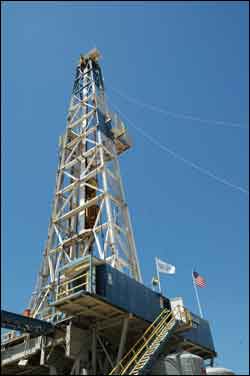

EarthScope Project Scientists Lead Modern-Day ’Journey to the Center of the Earth’ In a modern-day journey to the center of the Earth, geologists are exploring the structure and evolution of the North American continent at scales from hundreds of kilometers to less than a millimeter – from the structure of a continent, to individual faults, earthquakes and volcanoes. The project is called EarthScope. With approximately $200 million in funding from the National Science Foundation (NSF), EarthScope will be developed over the next five years. The project is expected to operate for an additional 15 years.
On Sept. 2, scientists studying San Andreas Fault geology will provide a first look at the multiple technologies EarthScope will use to explore the structure and tectonics of North America:
- A four-kilometer deep observatory drilled directly into the San Andreas fault to measure the physical conditions under which earthquakes there occur
- One of 875 permanent Global Positioning System (GPS) stations being installed, which can measure relative distance changes of less than 0.5 millimeters
- One of an eventual network of 400 seismographic stations that will spread across the United States, making observations at more than 2,000 geographic locations to map the structure and composition of North America
- The unique educational opportunities that EarthScope will provide as a national experiment, its sensors located at more than 3,000 sites across the United States to measure and observe plate tectonics in real time
Who: Scientists from NSF, the U.S. Geological Survey, and the EarthScope Project:
— Arden Bement, Acting Director, National Science Foundation
— Chip Groat, Director, U.S. Geological Survey — Greg van der Vink, Director, EarthScope
— Mark Zoback, Stanford University
— William Prescott, UNAVCO, Inc.
— David Simpson, Incorporated Research Institutions for Seismology
— Steve Hickman, U. S. Geological Survey — Paul Silver, Carnegie Institution of Washington
— Goran Ekstrom, Harvard University
What: EarthScope’s first look into North American continent geology
When: Thursday, Sept. 2, 7:00am to 1:00pm
Where: San Andreas Fault Depart from Paso Robles Inn, 1103 Spring Street Paso Robles, California 93466 (805) 238-2660














